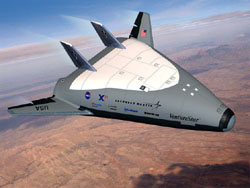|
 The NASA "Lockheed Martin" selected for a government cooperation on July
2nd, 1996 to design, build up and fly the experimental rocket-propelled
aircraft X 33. The shuttle X 33 will transport new technologies with an
unbelievably high strap safety and reliability. The costs to transport
payload to the universe will drop from $ 10,000 to $ 1,000. The NASA "Lockheed Martin" selected for a government cooperation on July
2nd, 1996 to design, build up and fly the experimental rocket-propelled
aircraft X 33. The shuttle X 33 will transport new technologies with an
unbelievably high strap safety and reliability. The costs to transport
payload to the universe will drop from $ 10,000 to $ 1,000.
Half a one degree prototype of a multiple usable strap is the shuttle X 33 (reusable
launch vehicle = RLV), it calls Lockheed Martin the "VentureStarTM". It is
the aim of the program to demonstrate the function ability of new
technologies, which are needed for an identical in quantity, an
EinstufenOrbiter RLV and engages therefore private industry RLV to build and
to use part of this century around which in the first one.
The design of Lockheed Martins shuttle X 33 is based on a special Flügkörper
with two revolutionary linear aerospikeraketen jet propulsion and a special
metallic and thermal protection system. It will be an autonomously
controlled shuttle but start vertically like a rocket, for one speeds reach
(//num(13) fach// sound velocity) and horizontally land again of more than
Mach 13 like an airplane. The X 33 flies also in the suborbital flight
highly and fast enough to have similar conditions as on an Orbitalenflug to
check the systems and performance completely. A demonstration if necessary
even is standardly the special (one seven days "turnaround" for time this
one is needed between landing and start), unite two-day "turnaround" for the
X 33 program.
A number of 15 flight tests is planned to begin at the turn of the century.
Exit flights of 450 miles are flown to Dugway Proving Ground, UT of the air
force base of Edward, CA. When politicians had more confidence in the
performance of the shuttle, they asked more difficult flights of Edward's
AFB with more to Malmstrom AFB than 950 miles, MT. The NASA has a budget the
industry team contains Ca of $ 941 million for the project X 33., conducted
by Lockheed Martin in Palmdale: AlliedSignal-Aerospace, Teterboro, Nj;
Boeing Rocketdyne, park Canoga, Ca; B.f. Goodrich Aerospace, Chula sight,
Ca; and Sverdrup, St. Louis, MO,
Center, Huntsville, Al, consists the management stake team of the NASA
Marshall Space Flight.
The program manager: Ames research center, Mountain view, CA; Dryden Flight
research center, Edward's Air Force cousin, Mojave, CA; Goddard Space Flight
center, Greenbelt, MD; Jet pro-pulse ion Laboratory, Pasadena, CA; Johnson
Space center, Houston, TX; Kennedy Space center, Fl; Langley research center,
Hampton, VA; Lewis research Center, Cleveland, oh; and Stennis Space center,
MS.
For more information about the shuttle X 33: http://x33.msfc.nasa.gov.
Source: Nasa,

|